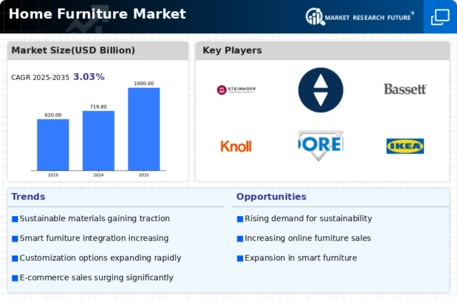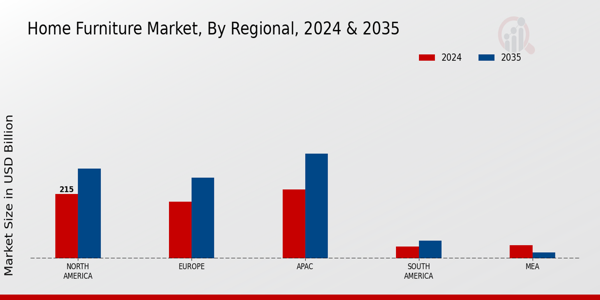E-commerce Growth
The rise of e-commerce significantly influences the Global Home Furniture Market Industry, transforming how consumers shop for furniture. Online platforms provide convenience and a wider selection, allowing consumers to compare prices and styles easily. This shift towards digital shopping is particularly appealing to younger demographics, who prioritize online experiences. The growth of e-commerce is expected to contribute to the market's expansion, as more consumers opt for online purchases over traditional retail. This trend aligns with the overall market trajectory, as the industry anticipates reaching a value of 1000 USD Billion by 2035.
Rising Urbanization
The Global Home Furniture Market Industry experiences a notable boost due to increasing urbanization trends. As more individuals migrate to urban areas, the demand for home furniture rises significantly. Urban dwellers often seek stylish and functional furniture to optimize limited living spaces. This trend is reflected in the projected market value of 719.8 USD Billion in 2024, indicating a robust consumer appetite for home furnishings. Urbanization not only influences design preferences but also drives innovation in furniture manufacturing, as companies strive to meet the evolving needs of city residents.
Sustainability Trends
Sustainability has emerged as a pivotal driver within the Global Home Furniture Market Industry. Consumers increasingly prefer eco-friendly materials and sustainable manufacturing practices, prompting manufacturers to adapt their offerings. This shift is not merely a trend but a response to growing environmental awareness. Companies that prioritize sustainability often see enhanced brand loyalty and market share. As the industry evolves, it is likely that sustainable furniture options will become mainstream, further contributing to the market's projected CAGR of 3.03% from 2025 to 2035. This focus on sustainability may redefine consumer expectations and industry standards.
Growing Disposable Income
An increase in disposable income across various demographics is a key driver for the Global Home Furniture Market Industry. As consumers have more financial flexibility, they are more inclined to invest in quality furniture that enhances their living spaces. This trend is particularly evident in emerging markets, where rising incomes correlate with a growing middle class. The anticipated growth of the market to 1000 USD Billion by 2035 underscores the potential for sustained investment in home furnishings. Higher disposable incomes enable consumers to prioritize aesthetics and functionality, thereby influencing purchasing decisions.
Technological Advancements
Technological innovations are reshaping the Global Home Furniture Market Industry, enhancing both production processes and consumer experiences. Smart furniture, which integrates technology for improved functionality, is gaining traction among tech-savvy consumers. Additionally, advancements in manufacturing techniques, such as 3D printing and automation, allow for more efficient production and customization options. These developments not only streamline operations but also cater to the growing demand for personalized furniture solutions. As the market adapts to these technological shifts, it is poised for continued growth, aligning with the projected market value of 719.8 USD Billion in 2024.
Market Trends and Projections

























